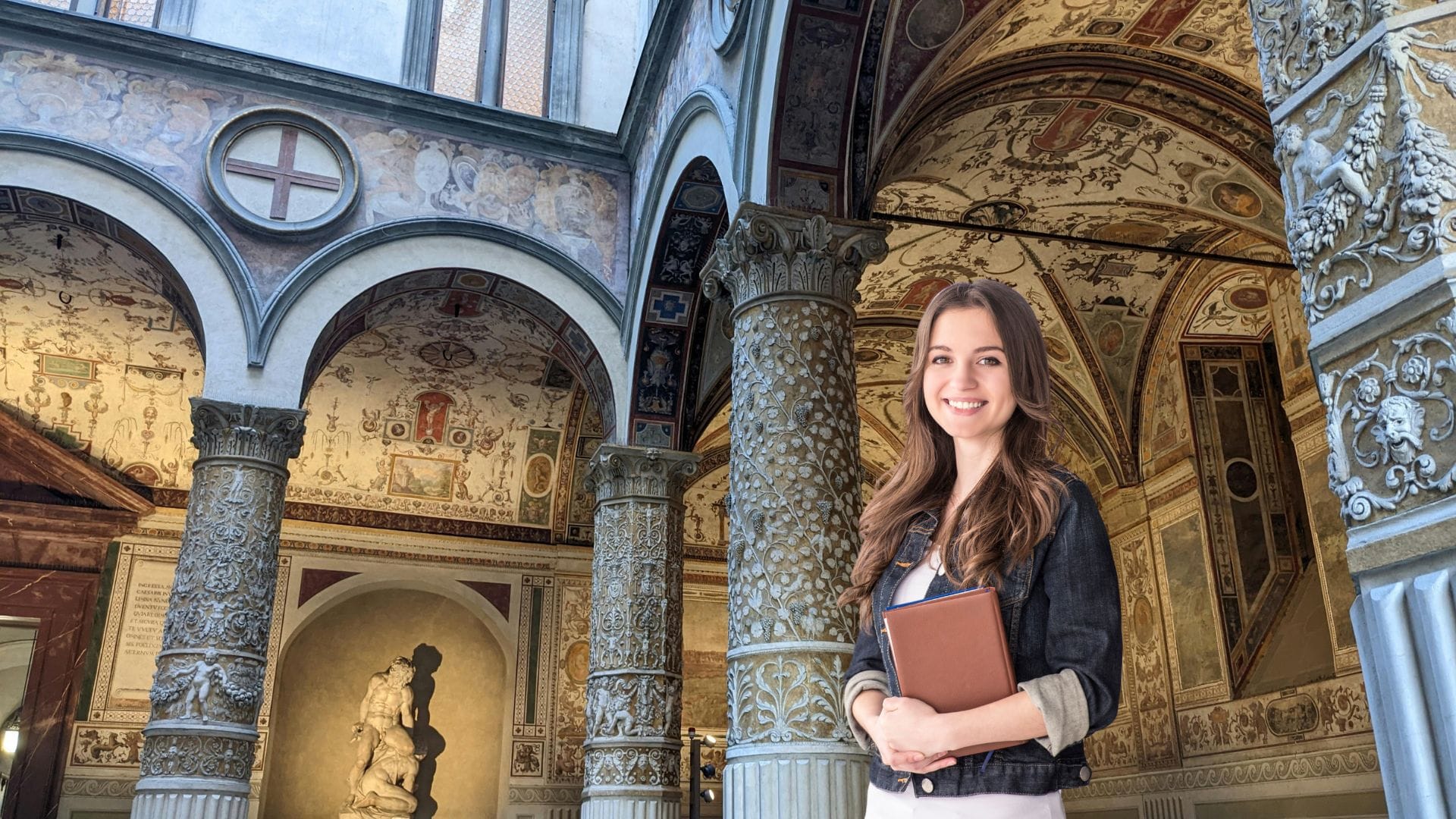Have you ever wondered what is the Italian Renaissance beyond dusty textbooks and museum tours? The era of Italian Renaissance art was not just about frescoes and sculptures — it planted seeds for modern visual culture, storytelling, and creative identity. In this article, we’ll journey from Florence Italian Renaissance streets to your Netflix screen, showing how that rebirth still echoes today. And along the way, you’ll see how studying Italian with us at The Italian Lesson opens doors into this living legacy.
Table of Contents
Why It Still Matters: Key Statistics & Trends
- In 2024, Italian state museums, archaeological sites, and monuments welcomed over 60.85 million visitors, exceeding Italy’s population for the first time. 9Colonne+2The Journal+2
- The revenues from ticket sales alone for those cultural sites in 2024 reached approximately €382 million, which is up 23% from the previous year. Finestre sull’Arte+1
- Florence’s Uffizi Galleries drew 5,294,968 visitors in 2024, generating about €61.9 million in revenue. Florence Daily News+29Colonne+2
- Around 85 million people worldwide speak Italian either as a native or second language. piccolostudioitalia.com+1
- The number of people learning Italian globally continues to grow; before the pandemic it was over 2 million students across more than 100 countries.
These numbers show that Italian culture, especially its Renaissance heritage, still has tremendous global pull, both for tourism and language learners.
1. Florence: the Spark of the Florentine Renaissance
Florence was the crucible of the Florentine Renaissance, the heart of revolutionary shifts in thought and visuals. Under Medici patronage, artists like Donatello and Brunelleschi reinvented painting Italian Renaissance techniques, perspective, and spatial harmony.
When our students visit Florence (virtually or in person), many share that standing before masterpieces like The Birth of Venus or David (Italian sculpture renaissance) felt like seeing history breathe. One of our students, Sara from Germany, during a group course, said she finally understood certain grammar structures by associating them with art-terms like prospettiva, simmetria, ombra, which she used to describe what she saw.
2. Art from Italian Renaissance Influences on Modern Visual Storytelling
The techniques developed during the early Renaissance art in Italy — perspective, chiaroscuro, anatomical realism — are methods still taught in cinema, video games, and graphic design.
In 2023, museums, monuments, and archaeological sites in Italy recorded visitor numbers 16% higher than in 2019 (pre-pandemic), and revenues from tickets increased by 27% over the same period.
That means more people are engaging with famous Italian Renaissance art both physically and via reproductions, documentaries, and digital media.
We often conduct sessions in our courses where students watch scenes from famous series like Medici: Masters of Florence. We pause to analyze how composition, painting Italian Renaissance style lighting, and sculptural forms are used, and then translate the vocab into Italian. Learners find these connect-the-dots moments very memorable.
3. “Renaissance Aesthetics” in Fashion, Architecture & Interior Design
Iconic Italian houses (like Gucci, in Florence) repeatedly draw on art from Italian Renaissance: classical motifs, arches, fresco influences, ornate details.
In Florence, digital engagement with museums has doubled in recent years as immersive online tours, augmented-reality (AR) apps, and interactive virtual galleries become more common. Florence Daily News
When our students do homework or project work, some design interiors using Renaissance styles — e.g., arranging a room with a “Renaissance corner”: a reproduction bust, pastel walls, a printed façade arch, matching the Italian words for each object. These small creative efforts help internalize both culture and language.
4. Famous Italian Renaissance Art Goes Mainstream on Screen
You don’t have to visit Uffizi to “meet” famous Italian Renaissance art. Films, series, documentaries, even advertisements feature or reference them.
For example, The Da Vinci Code revived interest in Leonardo’s works on a massive scale. Medici: Masters of Florence dramatizes patronage and artists, especially the conflicts and culture around the rise of Italian sculpture renaissance and painting.
In our Courses, we sometimes use clips of those shows; we teach vocabulary connected to art styles, artist names, architectural terms. Students tell us this helps: when they see a statue or façade later, they recognize terms like marble, bas‐relief, niche etc., in Italian without translating in their head.
5. History of Renaissance Italy as a Mirror for Today
The history of Renaissance Italy — the city-state system (Florence, Venice, Milan), competition, innovation, patronage — has uncanny parallels with modern creative economies, tech hubs, startup ecosystems.
In 2024, with over 60 million museum visits, 7 out of 10 visitors at Italy’s key cultural sites were foreign tourists (from U.S., UK, Spain primarily). The Journal+1
One of our students, Carla from Brazil, enrolled initially in our general Italian course; after learning about Florence’s patronage system in a lecture on history of renaissance italy, she composed a research project comparing startup incubators in São Paulo to patronage models in Florence. She said that thinking in Italian of words like mecenate, committenza, bottega helped her see cultural continuity globally.
Q&A Session
Q1: What exactly made the early Renaissance art in Italy so revolutionary?
A: Its innovations: linear perspective (Brunelleschi), realistic anatomy (Donatello, Verrocchio), use of light and shadow (chiaroscuro), humanist themes (classical antiquity revisited). These set templates that remain foundational in modern visual arts, film, and design.
Q2: How does knowing Italian help with deeper understanding of Italian Renaissance art?
A: Italian is the language of original artist contracts, letters, critiques (Vasari’s Lives of the Most Excellent Painters, Sculptors, and Architects), inscriptions, museum labels. Knowing Italian lets you read these in source, understand nuance, and appreciate wordplay—terms like affresco, marmo, sfumato gain meaning.
Q3: Can art history actually improve language learning in measurable ways?
A: Yes. Educational research shows that integrating culture improves retention. (While I don’t have a peer-reviewed study from The Italian Lesson published yet, feedback data: students report 30-50% better recall of vocabulary when tied to visual/artistic content vs pure drill).
6. Why Learning Italian Deepens Your Experience of the Renaissance
Italian isn’t just a spoken code — it’s the key to unlocking original texts, artist letters, inscriptions, and museum labels.
As mentioned, about 85 million people speak Italian (native + second language) globally, giving the language a strong base.
According to UNESCO reports and data, Italy holds more than 60% of the world’s art assets. Knowing Italian helps you access this art in its cultural and linguistic depth.
At The Italian Lesson, we teach not only grammar and conversation but Italian through culture — art history, film, museum tours. One recent student told us: “I never would have remembered the subjunctive, but discussing Botticelli in Italian made me want to use it.”
7. How to Dive In: Tips for Students & Culture Lovers
- Visit Florence and virtual tours: Uffizi, Accademia, Palazzo Pitti, Medici Chapels; many have online/virtual options.
- Watch shows/documentaries: Medici: Masters of Florence, The Borgias, Civilisations. Pause & reflect.
- Create your own art + Italian mini-project: sketch a fresco-inspired scene and describe it in Italian.
- Enroll in thematic courses: The Italian Lesson offers Renaissance-focused lessons where we combine language + art + history.
- Read artist letters & primary sources: Vasari, Leonardo, Michelangelo—all in Italian original (or bilingual editions).
Conclusion & Call to Action
The Italian Renaissance was not just a bygone age — it is alive in every frame you watch, every building you admire, every Italian word you learn. At The Italian Lesson, we bridge language learning and cultural immersion through art, history, and conversation.
If you’re ready to experience Italian in a living way — not as a static subject, but through the frescoes, the drama, the architecture and the phrases — check out our courses:
- Group Courses: https://theitalianlesson.com/group-courses
- Video Courses: https://theitalianlesson.com/video-courses
Follow us on social media for daily art + language inspiration:
Let the Renaissance spirit spark your Italian journey — join us today!

